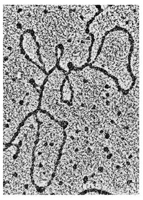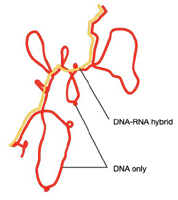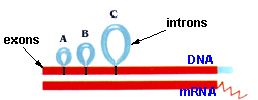



back
| Richard J. Roberts and Phillip A. Sharp (1993 Nobel Prize) made their amazing discovery of the existence of split genes in the adenovirus, when they examined a hybridized nucleic acid molecule made between a adenoviral mRNA and its template DNA in the electron microscope. They observed that the mRNA was much shorter in length and thus was not encoded as an equal colinear segment of the DNA molecule (see below). Instead, large loops of unhybridized DNA (A, B and C in figure) were seen. Their interpretation was that the mature messenger RNA was derived from four discountinuous segments on the viral DNA. The segments retained in the mRNA they called EXONS and the intervening sequences (A, B and C), which are excised during mRNA processing and maturation, are called INTRONS. |
|
 |
 |
| showed that the primary transcript
& mRNA |
were not the same size |
|
a DNA Gene is
longer than its functional mRNA back |
|
|
Alternative
Splicing: In this system, the female-specific sxl-protein is a key regulator. It controls a cascade of alternative RNA splicing decisions that finally result in female flies. |

Sex in Drosophila is
thus largely determined by |
| Other examples : Thalassemia Tropomyosin. back to Molecular Genetics | |
end.